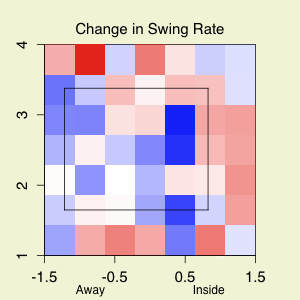Do Better Players Have More Twitter Followers?
I was reading R.J. Anderson’s recent article on Jason Heyward and Twitter when this question struck me. Obviously better players tend to be more popular, but Twitter offers access to a player’s thoughts, the quality of which might be independent of a player’s ability on the field. So there is at least the possibility that the best players might not have the most popular Twitter accounts.
Here I use FAN projected WAR as a measure of ‘how good’ a player is and compare that to his number of Twitter followers. The number of followers is on a log scale to accommodate the huge range in number of followers (under a thousand to over a million). Players with less than 15 fan projections were left out except for Jason Heyward, whom I just could not leave out. For him I used his current 2.1 WAR plus his CHONE projected rest of the season 1.6 WAR. I got the list of MLB players with Twitter accounts here.

First off the clear outlier is Nick Swisher (@NickSwisher). He has over 1.2 million followers, while his teammate CC Sabathia (@CC_Sabathia) is a distance second with just over 50 thousand followers. Ignoring how Swisher got so many followers, there is a slight trend for better players to have more followers — the linear relationship between projected WAR and log(followers) has a p value of 0.07 and an r-squared of 0.08, and on average each additional win results in 1.25 times more followers. This linear relationship between projected WAR and log(followers) is an exponential relationship between projected WAR and actual number of followers
With Swisher removed there is enough room to plot the remaining players identified by their Twitter account names.

Here it looks more like the lower limit of number of followers is determined by a player’s projected WAR and then there is considerable variation above that limit. For example, David Ortiz (@davidortiz), Carlos Delgado (@carlosdelgado21), and C.J. Wilson (@str8edgeracer) are low projected WAR players with lots of followers. Ortiz and Delgado probably because they both have long histories as very good players and Wilson because he has a particularly active and interesting twitter account.
So there is a weak trend towards better players having more followers with considerable variation based on small market/big market, the player’s history, the quality and quantity of his tweets and any number of other things.
 In an injury-depleted Phillies bullpen
In an injury-depleted Phillies bullpen 




 We here at Fangraphs are big
We here at Fangraphs are big